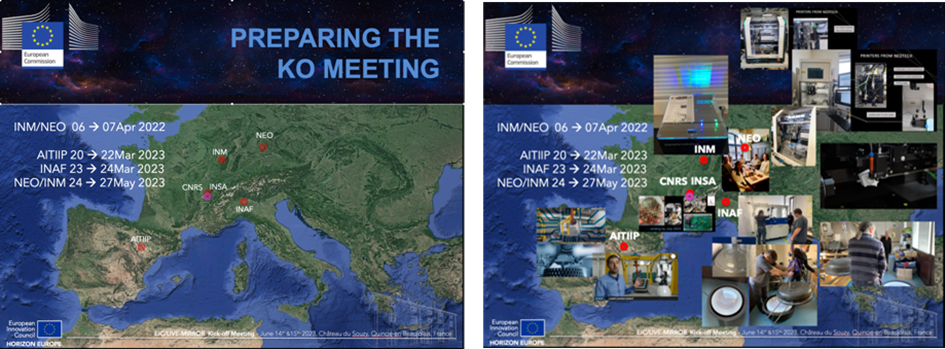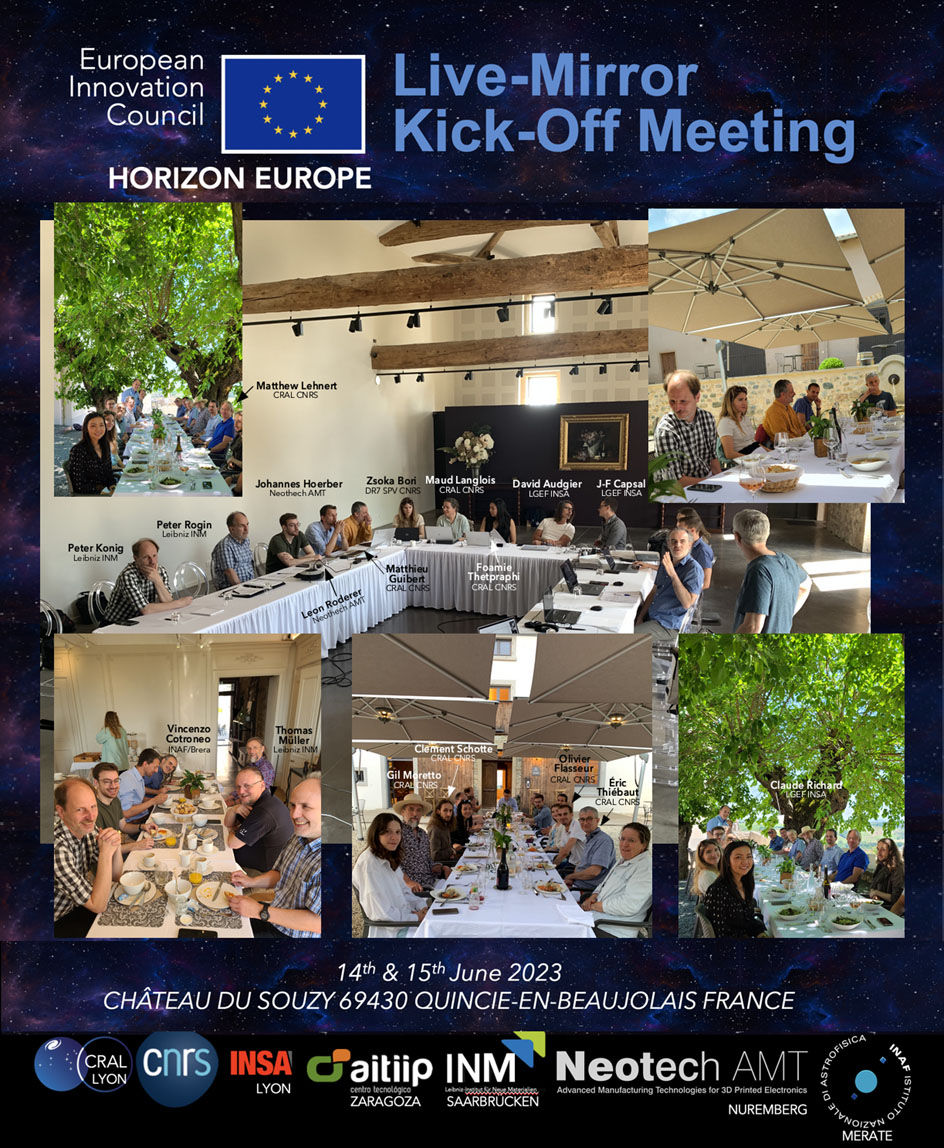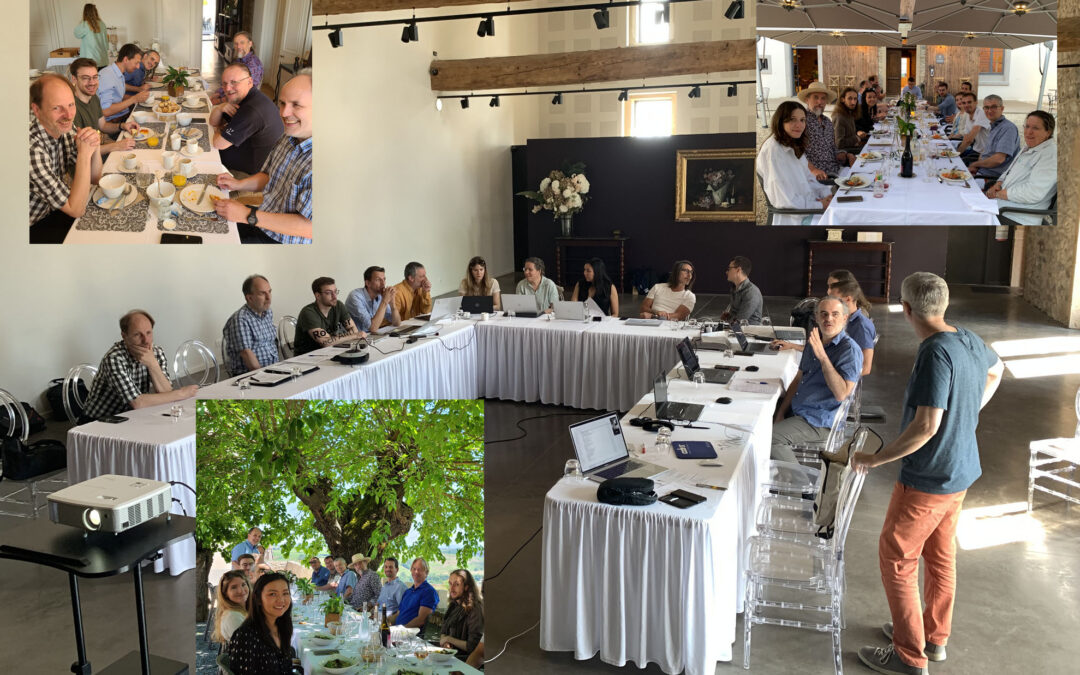Introducing Live-Mirror: A Collaborative Start and the Role of the Kick-Off Meeting
Funded by the EU’s Horizon Europe Programme under Grant Agreement number 101099220, Live-Mirror is an EIC Pathfinder project composed of four academic partners (CNRS, INSA Lyon, INAF, and INM/Leibniz Institute for New Materials), a technological foundation (AITIIP), and an industrial enterprise (Neotech AMT GmbH). It aims to develop ultralight, self-correcting mirrors for the next generation of large optical telescopes and solar energy concentrators.
With such ambitious goals, a well-organised start is paramount. A project kick-off meeting serves as the cornerstone for any large-scale research initiative. It is more than just formal introductions; it sets the stage for a unified vision, clear goals, and effective collaboration among all partners. For the EIC Live-Mirror project, this meeting was critical to establish the groundwork for a four-year exploration into advanced optics technology. The Project Investigator (PI), Gil Moretto (CRAL/CNRS – France), had already laid the groundwork by meeting with partners in Saarbrucken (INM/Leibniz Institute for New Materials), Nuremberg (Neotech AMT GmbH), Zaragoza (AITIIP), and Merate (INAF)[1] to ensure everything was prepared for this key event.

Day 1: Morning Session on Glass Deterministic Slumping
The first day began with a welcome breakfast, where team members introduced themselves and set the tone for the meeting. The sessions kicked off with an overview of the EIC Live-Mirror project by PI Gil Moretto. The morning’s focus was on “Glass Deterministic Slumping”, a technology crucial for creating precisely shaped mirrors. Presentations included topics like developing high-temperature moulds (José Antonio Dieste, AITIIP – Spain) and addressing the challenges associated with glass slumping to achieve the desired aspheric shapes (Vincenzo Cotroneo, INAF – Italy). Discussions arising from these presentations were lively. They highlighted potential risks and the strategies to mitigate them, fostering a collaborative and forward-thinking environment.
Day 1: Afternoon Session on Additive and Flexible EAP E-Sensors & E-Actuators
The afternoon sessions shifted focus to additive and flexible electroactive polymers (EAP) e-sensors and e-actuators, which are integral to developing responsive and adaptable systems for the Live-Mirror project. Kritsadi Thetpraphi (CRAL/CNRS – France) opened the session by recalling the results of the ANR LiveMetaOptics project, which lays the foundations for EIC Live-Mirror. This was followed by insights from Jean-Fabien Capsal (INSA Lyon – France) on optimizing EAP actuators and sensors, and from Peter König (INM/Leibniz Institute for New Materials – Germany) on optimizing flexible electronic ink. After the coffee break, Peter Rogin (INM/Leibniz Institute for New Materials – Germany) discussed advancements in coating very thin slumped glass, while Johannes Hoerber (Neotech Amt GmbH – Germany) provided an update on the additive manufacturing facilities. The session concluded with an overall discussion on the risks and challenges associated with additive manufacturing, a crucial aspect of developing “Live-Mirrors”.
Day 2: Metrology, Calibration, and Future Directions
The second day was dedicated to the processes of metrology, calibration, and validation, essential for ensuring precise measurements and control in optical systems. Experts like Eric Thiébaut and Maud Langlois (CRAL/CNRS – France) illustrated the challenges of real-time control and the integration of advanced metrology techniques. Facilitated by Gil Moretto, a discussion took place among the project partners regarding on-bench assessments, integration, and testing. The meeting concluded with a session on legal and financial considerations, led by Zsoka Bori (SPV/CNRS – France), and a discussion on the next steps for the project’s future.
The Significance of This Project
The EIC Live-Mirror project aims to push the boundaries of optical technology, with applications that could revolutionize fields like astronomy, wireless optical communication, solar energy production, space surveillance, and beyond. The kick-off meeting was not merely a procedural step; it was a critical opportunity to align diverse expertise and establish a shared vision. With a detailed roadmap and a collaborative spirit, the project is set to achieve significant advancements over the next 48 months.
As team members departed, they left with a shared commitment to pushing the boundaries of optical science. The EIC Live-Mirror project is not only about developing new technologies; it represents a bold step toward exploring new scientific frontiers, and this kick-off meeting was the ideal starting point for that journey.

[1] INAF officially joined the Live-Mirror Consortium in Spring 2024 upon acceptance by the European Commission of the Grant Agreement Amendment request.

